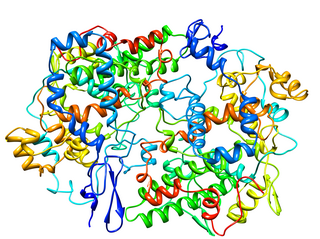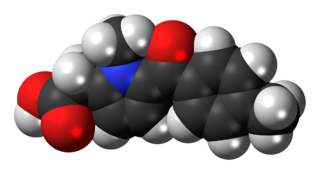Related Research Articles

Ketoprofen is one of the propionic acid class of nonsteroidal anti-inflammatory drugs (NSAID) with analgesic and antipyretic effects. It acts by inhibiting the body's production of prostaglandin.

Non-steroidal anti-inflammatory drugs (NSAID) are members of a therapeutic drug class which reduces pain, decreases inflammation, decreases fever, and prevents blood clots. Side effects depend on the specific drug, its dose and duration of use, but largely include an increased risk of gastrointestinal ulcers and bleeds, heart attack, and kidney disease.
Essential fatty acids, or EFAs, are fatty acids that humans and other animals must ingest because the body requires them for good health, but cannot synthesize them.

Cyclooxygenase (COX), officially known as prostaglandin-endoperoxide synthase (PTGS), is an enzyme that is responsible for biosynthesis of prostanoids, including thromboxane and prostaglandins such as prostacyclin, from arachidonic acid. A member of the animal-type heme peroxidase family, it is also known as prostaglandin G/H synthase. The specific reaction catalyzed is the conversion from arachidonic acid to prostaglandin H2 via a short-living prostaglandin G2 intermediate.

Borage, also known as starflower, is an annual herb in the flowering plant family Boraginaceae. It is native to the Mediterranean region, and has naturalized in many other locales.

Eicosanoids are signaling molecules made by the enzymatic or non-enzymatic oxidation of arachidonic acid or other polyunsaturated fatty acids (PUFAs) that are, similar to arachidonic acid, around 20 carbon units in length. Eicosanoids are a sub-category of oxylipins, i.e. oxidized fatty acids of diverse carbon units in length, and are distinguished from other oxylipins by their overwhelming importance as cell signaling molecules. Eicosanoids function in diverse physiological systems and pathological processes such as: mounting or inhibiting inflammation, allergy, fever and other immune responses; regulating the abortion of pregnancy and normal childbirth; contributing to the perception of pain; regulating cell growth; controlling blood pressure; and modulating the regional flow of blood to tissues. In performing these roles, eicosanoids most often act as autocrine signaling agents to impact their cells of origin or as paracrine signaling agents to impact cells in the proximity of their cells of origin. Eicosanoids may also act as endocrine agents to control the function of distant cells.
Anti-inflammatory or antiphlogistic is the property of a substance or treatment that reduces inflammation or swelling. Anti-inflammatory drugs, also called anti-inflammatories, make up about half of analgesics. These drugs remedy pain by reducing inflammation as opposed to opioids, which affect the central nervous system to block pain signaling to the brain.
COX-2 inhibitors (coxibs) are a type of nonsteroidal anti-inflammatory drug (NSAID) that directly target cyclooxygenase-2, COX-2, an enzyme responsible for inflammation and pain. Targeting selectivity for COX-2 reduces the risk of peptic ulceration and is the main feature of celecoxib, rofecoxib, and other members of this drug class.
gamma-Linolenic acid or GLA is an n−6, or omega-6, fatty acid found primarily in seed oils. When acting on GLA, arachidonate 5-lipoxygenase produces no leukotrienes and the conversion by the enzyme of arachidonic acid to leukotrienes is inhibited.

Borago, or borage, is a genus of five species of herbs native to the Mediterranean, with one species, Borago officinalis, cultivated and naturalized throughout the world.

Oenothera biennis, the common evening-primrose, is a species of flowering plant in the family Onagraceae, native to eastern and central North America, from Newfoundland west to Alberta, southeast to Florida, and southwest to Texas, and widely naturalized elsewhere in temperate and subtropical regions. Evening primrose oil is produced from the plant.

Carprofen is a non-steroidal anti-inflammatory drug (NSAID) of the carbazole and propionic acid class that was previously for use in humans and animals, but is now only available to veterinarians for prescribing as a supportive treatment for various conditions in only animals. Carprofen reduces inflammation by inhibition of COX-1 and COX-2; its specificity for COX-2 varies from species to species. Marketed under many brand names worldwide, carprofen provides day-to-day treatment for pain and inflammation from various kinds of joint pain, as well as post-operative pain.
Dihomo-γ-linolenic acid (DGLA) is a 20-carbon ω−6 fatty acid. In physiological literature, it is given the name 20:3 (ω−6). DGLA is a carboxylic acid with a 20-carbon chain and three cis double bonds; the first double bond is located at the sixth carbon from the omega end. DGLA is the elongation product of γ-linolenic acid. GLA, in turn, is a desaturation product of linoleic acid. DGLA is made in the body by the elongation of GLA, by an efficient enzyme which does not appear to suffer any form of (dietary) inhibition. DGLA is an extremely uncommon fatty acid, found only in trace amounts in animal products.
David Frederick Horrobin was a British-Canadian entrepreneur, medical researcher, author and editor. He is best known as the founder of the biotechnology company Scotia Holdings and as a promoter of evening primrose oil as a medical treatment, Horrobin was founder and editor of the journals Medical Hypotheses and Prostaglandins, Leukotrienes and Essential Fatty Acids, the latter journal co-founded with his then graduate student Morris Karmazyn.

Pyrrolizidine alkaloids (PAs), sometimes referred to as necine bases, are a group of naturally occurring alkaloids based on the structure of pyrrolizidine. Pyrrolizidine alkaloids are produced by plants as a defense mechanism against insect herbivores. More than 660 PAs and PA N-oxides have been identified in over 6,000 plants, and about half of them exhibit hepatotoxicity. They are found frequently in plants in the Boraginaceae, Asteraceae, Orchidaceae and Fabaceae families; less frequently in the Convolvulaceae and Poaceae, and in at least one species in the Lamiaceae. It has been estimated that 3% of the world’s flowering plants contain pyrrolizidine alkaloids. Honey can contain pyrrolizidine alkaloids, as can grains, milk, offal and eggs. To date (2011), there is no international regulation of PAs in food, unlike those for herbs and medicines.

Tolmetin is a nonsteroidal anti-inflammatory drug (NSAID) of the heterocyclic acetic acid derivative class. It is used primarily to reduce hormones that cause pain, swelling, tenderness, and stiffness in conditions such as osteoarthritis and rheumatoid arthritis, including juvenile rheumatoid arthritis. In the United States it is marketed as Tolectin and comes as a tablet or capsule.

Flunoxaprofen, also known as Priaxim, is a chiral nonsteroidal anti-inflammatory drug (NSAID). It is closely related to naproxen, which is also an NSAID. Flunoxaprofen has been shown to significantly improve the symptoms of osteoarthritis and rheumatoid arthritis. The clinical use of flunoxaprofen has ceased due to concerns of potential hepatotoxicity.

Thesinine is a pyrrolizidine alkaloid first isolated from Thesium minkwitzianum from which it derives its name. It is also found in the flowers and seeds of borage.

Amabiline is a pyrrolizidine alkaloid first isolated in 1967 from Cynoglossum amabile. It is also found in the seeds and flowers of borage and in borage seed oil.
Prostaglandin inhibitors are drugs that inhibit the synthesis of prostaglandin in human body. There are various types of prostaglandins responsible for different physiological reactions such as maintaining the blood flow in stomach and kidney, regulating the contraction of involuntary muscles and blood vessels, and act as a mediator of inflammation and pain. Cyclooxygenase (COX) and Phospholipase A2 are the major enzymes involved in prostaglandin production, and they are the drug targets for prostaglandin inhibitors. There are mainly 2 classes of prostaglandin inhibitors, namely non- steroidal anti- inflammatory drugs (NSAIDs) and glucocorticoids. In the following sections, the medical uses, side effects, contraindications, toxicity and the pharmacology of these prostaglandin inhibitors will be discussed.
References
- 1 2 3 4 5 6 7 8 9 10 Borage at Sloan-Kettering website
- 1 2 3 "Borage". WebMD. Retrieved 19 February 2014.
- ↑ Henz, BM; Jablonska, S; Van De Kerkhof, PC; Stingl, G; Blaszczyk, M; Vandervalk, PG; Veenhuizen, R; Muggli, R; Raederstorff, D (1999). "Double-blind, multicentre analysis of the efficacy of borage oil in patients with atopic eczema". The British Journal of Dermatology. 140 (4): 685–8. doi:10.1046/j.1365-2133.1999.02771.x. PMID 10233322. S2CID 21396418.
- ↑ Takwale, A; Tan, E; Agarwal, S; Barclay, G; Ahmed, I; Hotchkiss, K; Thompson, JR; Chapman, T; Berth-Jones, J (2003). "Efficacy and tolerability of borage oil in adults and children with atopic eczema: Randomised, double blind, placebo controlled, parallel group trial". BMJ (Clinical Research Ed.). 327 (7428): 1385. doi:10.1136/bmj.327.7428.1385. PMC 292992 . PMID 14670885.
- ↑ Bamford, JT; Ray, S; Musekiwa, A; van Gool, C; Humphreys, R; Ernst, E (Apr 30, 2013). "Oral evening primrose oil and borage oil for eczema". The Cochrane Database of Systematic Reviews. 4 (4): CD004416. doi:10.1002/14651858.CD004416.pub2. PMC 8105655 . PMID 23633319.
- ↑ Dodson, Craig D.; Stermitz, Frank R. (1986). "Pyrrolizidine alkaloids from borage (Borago officinalis) seeds and flowers". Journal of Natural Products. 49 (4): 727–728. doi:10.1021/np50046a045.
- ↑ Parvais, O.; Vander Stricht, B.; Vanhaelen-Fastre, R.; Vanhaelen, M. (1994). "TLC detection of pyrrolizidine alkaloids in oil extracted from the seeds of Borago officinalis". Journal of Planar Chromatography--Modern TLC. 7 (1): 80–82.
- ↑ Wretensjoe, Inger; Karlberg, Bo. (2003). "Pyrrolizidine alkaloid content in crude and processed borage oil from different processing stages". Journal of the American Oil Chemists' Society. 80 (10): 963–970. doi:10.1007/s11746-003-0804-z. S2CID 94575246.
- ↑ Kast, RE (2001). "Borage oil reduction of rheumatoid arthritis activity may be mediated by increased cAMP that suppresses tumor necrosis factor-alpha". International Immunopharmacology. 1 (12): 2197–9. doi:10.1016/s1567-5769(01)00146-1. PMID 11710548.
- ↑ Al-Khamees, W. A. A.; Schwartz, M. D.; Alrashdi, S.; Algren, A. D.; Morgan, B. W. (2011). "Status Epilepticus Associated with Borage Oil Ingestion". Journal of Medical Toxicology. 7 (2): 154–157. doi:10.1007/s13181-011-0135-9. PMC 3724443 . PMID 21387119.
- ↑ Spinella, M. (2001). "Herbal Medicines and Epilepsy: The Potential for Benefit and Adverse Effects". Epilepsy & Behavior. 2 (6): 524–532. doi:10.1006/ebeh.2001.0281. PMID 12609386. S2CID 29280247.